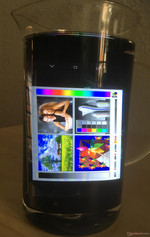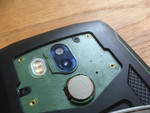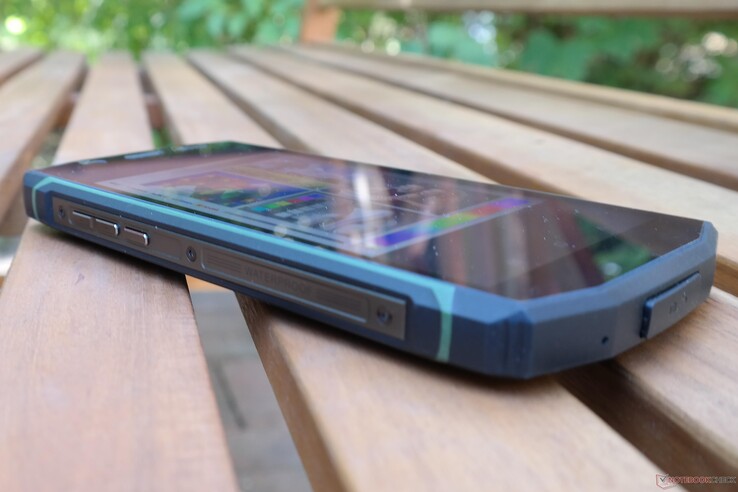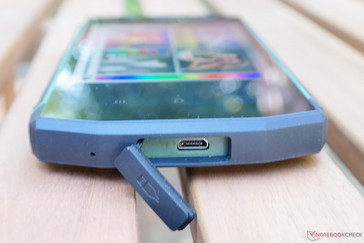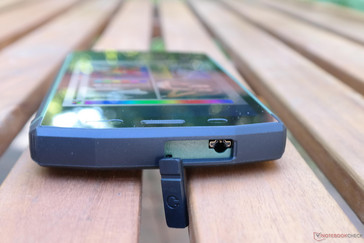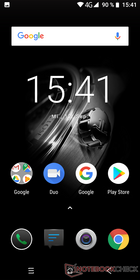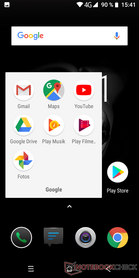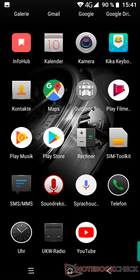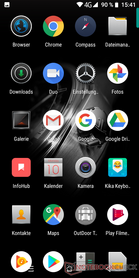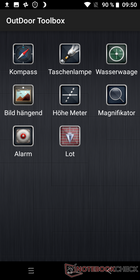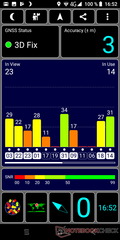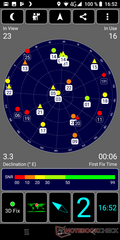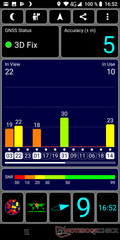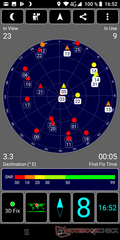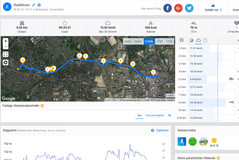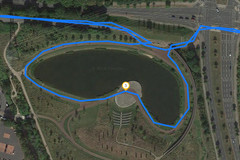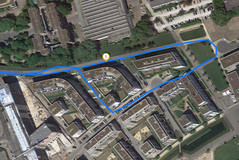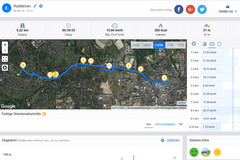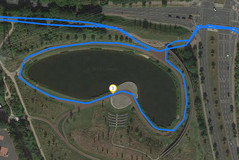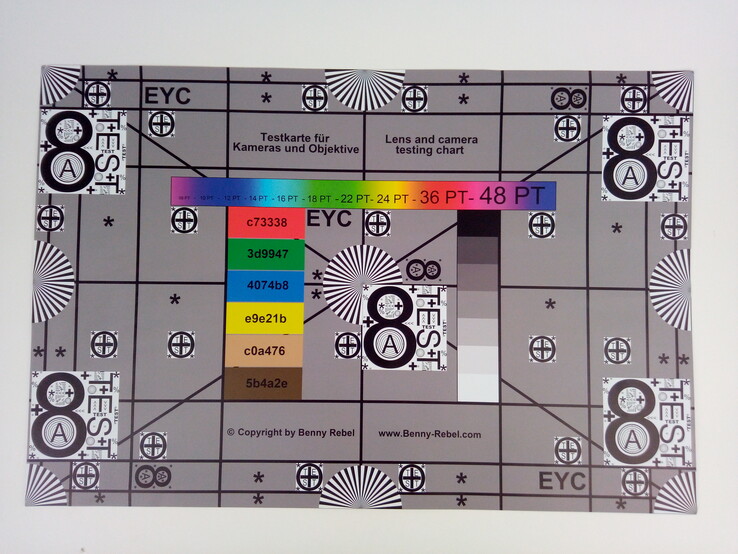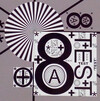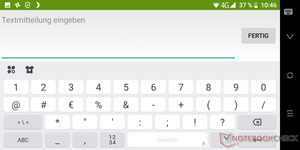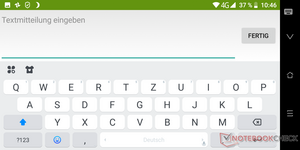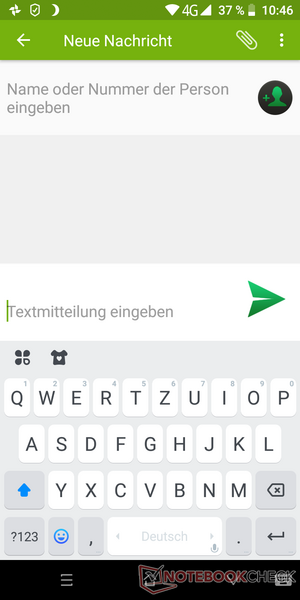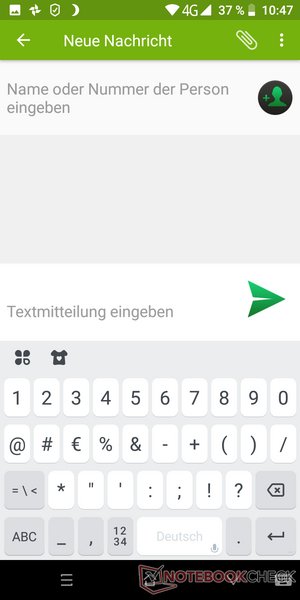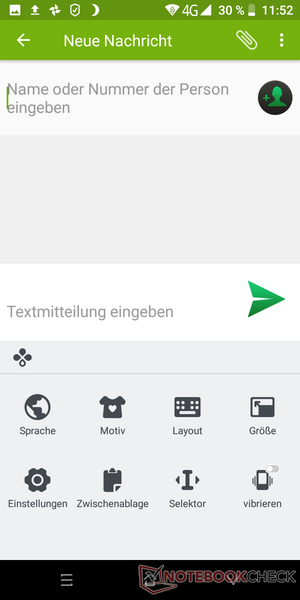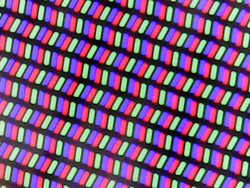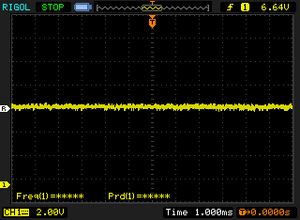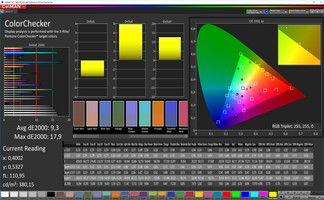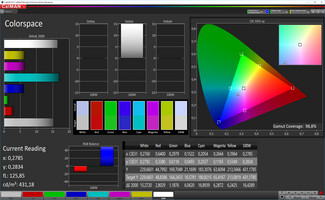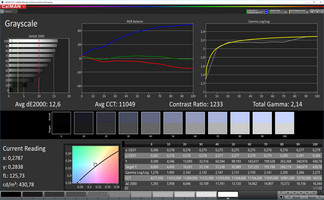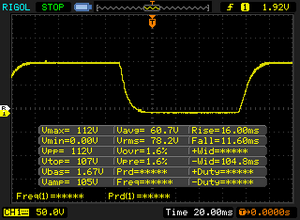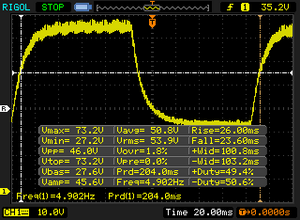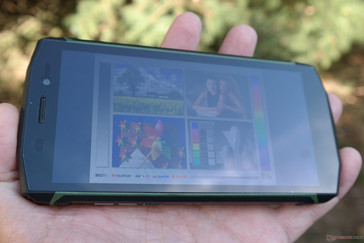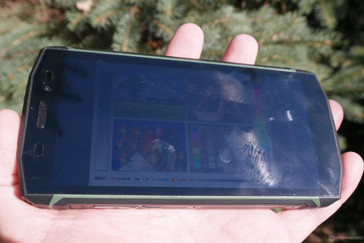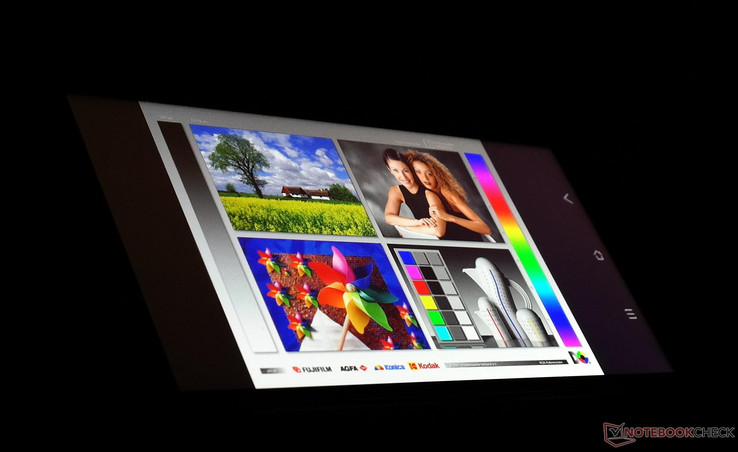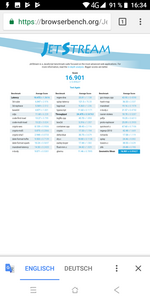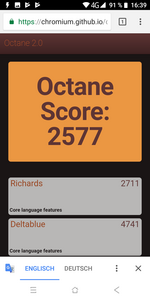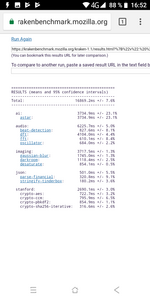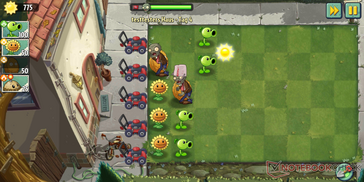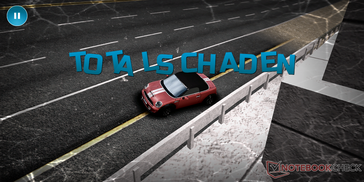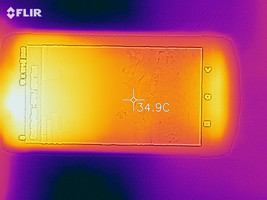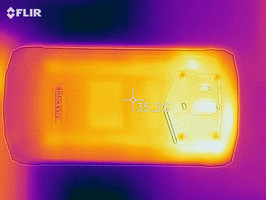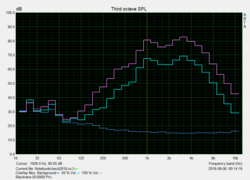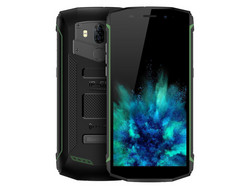Blackview BV5800 Pro Smartphone Smartphone Review

The Blackview BV5800 Pro is not the first smartphone designed for outdoor use, nor is it the first that we have reviewed. The BV5800 Pro looks robust like the BV8000 Pro and BV9000 Pro that we have already reviewed. The BV5800 Pro gives this impression with its visible screws and its metal and rubber case. While the BV5800 Pro shares its siblings' aesthetics, Blackview has equipped the device with low-end hardware. The BV5800 is powered by a MediaTek MT6739 SoC that integrates a PowerVR Rouge GE8100 GPU from Imagination Technologies rather than an ARM Mali GPU with which we typically associate MediaTek SoCs. Moreover, Blackview has opted for 2 GB of RAM and 16 GB of eMMC memory, in contrast to the memory that the manufacturer has used in its other smartphones that we have reviewed.
The BV5800 Pro costs 140 Euros (~$164), which is rather steep given the device’s weak hardware. The BV5800 Pro will have dissimilar performance to those of its siblings, so we have chosen to compare our test device against other outdoors phones like the CAT S41, the Crosscall Action-X3, the CUBOT King Kong, the Poptel P9000 Max and the Ulefone Armor X. The specifications of our comparison devices are somewhat divergent, but we thought it important to compare the BV5800 Pro against other robustly designed smartphones.
Case
We have had no complaints thus far concerning the craftsmanship of Blackview smartphones. All the company's devices are robust and well-made, and the BV5800 Pro looked set to follow this trend on first impressions. Our attempts at bending or twisting the BV5800 Pro practically ended by just looking at our test device. The device looks well-built, but this sturdiness comes at a cost to dimensions and weight with the BV5800 Pro measuring 15.5 mm thick and weighing a whopping 220 g. The BV5800 Pro is large when compared with most smartphones, but it is relatively compact compared to some of our comparison devices.
Our test device has “IP 68 submersible”, “dustproof” and “waterproof” emblazoned on its case with the dust and water ingress seemingly being secured by plastic knobs surrounding the ports. In contrast, the combined microSD and SIM-card slot is integrated within the case and has an inner rather than outer rubber seal around it. Blackview even designed the BV8000 Pro with a card slot that could only be removed with a screwdriver. The BV5800 Pro’s fingerprint scanner is on the rear of the smartphone like many devices.
We also tested the BV5800 Pro’s buoyancy since it is designed to withstand the elements. We placed our test device in a water bath, which appeared to cause no damage at first. However, then we noticed that the camera lens had misted up and that various droplets of water had formed underneath the metal plate surrounding the camera. Blackview has not sealed the removable metal back plate with any waterproofing, and so water can easily get into the device. Shortly afterwards the touchscreen stopped working. Blackview claims that the BV5800 Pro is waterproof up to 1.5 m for two hours, but our test device could not survive a shallow water bath.
Connectivity
Blackview has once again used a MediaTek SoC in one of its devices. The BV5800 Pro is powered by a MediaTek MT6739 SoC that integrates a PowerVR GE8100 GPU. The BV5800 Pro is relatively poorly equipped with its 2 GB of RAM and 16 GB of eMMC storage. Overall, the BV5800 Pro is a lower mid-range smartphone, but we do not tend to see slower SoCs powering equivalent devices.
The remaining connections are in the usual places with the micro USB port on the underside and the headphone jack on the top of the device. Both ports are protected by rubber caps, which first must be removed before connecting peripherals to the device. The card slot and power button are on the right-hand side of the device; the volume rocker and an additional button are on the opposite side. You will need to install a special program to make use of the additional button though. The BV5800 Pro also supports USB On-The-Go (OTG) so that you can connect peripherals to the device and charge other smartphones from it.
According to Blackview, the BV5800 Pro supports Qi wireless charging too.
Moreover, the BV5800 Pro has an FM radio receiver that works with the preinstalled radio app.
Software
The BV5800 Pro ships with Android Oreo 8.1. The OS is practically a stock experience albeit it with a few minor graphical adjustments. Our test device has some additional preinstalled apps too, including an outdoor toolbox with a compass, flashlight, a spirit level and an app to help you hang pictures. The BV5800 Pro supports multi-user accounts as per Oreo 8.1.
Communication & GPS
The BV5800 Pro supports all important 2G, 3G and 4G frequencies for German mobile networks including the important Band 20.
The device has less convincing Wi-Fi performance though. We tested our test device and our comparison devices’ Wi-Fi performance with our Linksys EA 8500 reference router. Our test device occupies the midfield in our comparison table, but our comparison devices have relatively slow Wi-Fi performance too. Only the Crosscall Action-X3 achieved over 100 Mb/s while the devices at the bottom of our comparison table, the CAT S41 and the CUBOT King Kong, scored less than 60 Mb/s in both iperf3 Client Wi-Fi tests.
By contrast, modern flagship devices like the iPhone X have up to 10 times faster Wi-Fi performance in our tests. Whether our test results would reflect the difference in Wi-Fi performance in daily use depends on your Wi-Fi network speed. The BV5800 Pro averaged 93.5 Mb/s across both Wi-Fi tests, so you will not notice the difference in potential Wi-Fi performance between the BV5800 Pro and flagship devices like the iPhone X if your Wi-Fi network speed is below 100,000 kbps. You would notice the difference when streaming movies from a NAS drive, but again this is relatively niche. Regardless, the Blackview BV5800 Pro has relatively poor Wi-Fi performance.
| Networking | |
| iperf3 transmit AX12 | |
| Crosscall Action-X3 | |
| Ulefone Armor X | |
| Blackview BV5800 Pro | |
| Poptel P9000 Max | |
| Cubot King Kong | |
| CAT S41 | |
| iperf3 receive AX12 | |
| Crosscall Action-X3 | |
| Ulefone Armor X | |
| Blackview BV5800 Pro | |
| Poptel P9000 Max | |
| Cubot King Kong | |
| CAT S41 | |
Blackview devices have performed well in our GPS tests, and the BV5800 Pro continues in this vein. The BV5800 Pro uses A-GPS and Glonass for location services. Our test device finds an outdoor satellite fix with up to three meters accuracy according to GPS Test and an accuracy of up to four meters when tested indoors. These values are particularly impressive given the BV5800 Pro’s price.
We took the BV5800 Pro on a bike ride to test its location accuracy against a professional navigation device, the Garmin Edge 500. Our test device performed well and plotted 20 m further on our bike ride than the 9.2 km that the Garmin recorded. Our test device is impressively accurate in this regard, and the blue line on the map barely slipped from the actual route. The BV5800 Pro plotted a more angular route than the Garmin, but that is probably because the Garmin takes GPS readings more frequently than our test device. In short, the BV5800 Pro is an excellent navigational companion.
Telephone Function & Call Quality
Blackview has preinstalled the standard Google Contacts and Phone app on the BV5800 Pro. Calls are free of noise but both sides of the call sound rather dull because of the device’s apparent watertight construction. This should not impede making and receiving calls though.
The BV5800 Pro’s included headphones look like Apple’s old wired headphones with a 3.5 mm jack, albeit the cable is considerably tauter than Apple’s old headphones. Additionally, the included headphones only have an inline microphone and a button to answer calls; there are no volume buttons. The sound quality is lacking too. The BV5800 Pro’s headphones lack the bass and the sound balance of Apple’s old headphones. By contrast, the BV5800 Pro’s included headphones have a high maximum volume, so much so that they would be too loud for most ears.
Cameras
In short, do not place any high hopes on the BV5800 Pro’s cameras.
Blackview has equipped the BV5800 Pro with a 13 MP Sony IMX134 Exmor rear-facing sensor that takes useful photos, but we faced several issues when we tried to take decent photos. Firstly, the color reproduction is far from natural, more on that below. Moreover, the camera struggles to focus on small objects and sometimes focuses on the background rather than a small foreground object. We failed several times to photograph delicate fauna because of the camera’s focusing issue, examples of which we have included below. Our test device focused on our ladybird pinwheel differently in each of three test shots and got the focus wrong in at least some of those photos.
The rear-facing camera particularly struggles in low light. Photos lack contrast, sharpness and generally are a blurry mess.
It is possible that the software is just poorly optimized and that the focusing issue could be rectified in an update, but we cannot rule out that the BV5800 Pro just has a poor rear-facing camera.
The BV5800 Pro has an 8 MP front-facing camera that is not much better either. The camera is good enough for making video calls or taking simple selfies, but that is about all it is good for.
Our test device performed better in controlled lighting conditions though. The dual rear-facing cameras produced much sharper and more detailed images under these conditions, albeit with underwhelming color accuracy. Practically all colors are reproduced too brightly while black has a visible green tint to it.
Accessories & Warranty
The BV5800 Pro includes plenty of accessories in its stylish box. Firstly, there is a quick-start guide in English, German, Portuguese, Russian and Spanish. Blackview has also included a charger, a USB OTG cable and two Micro USB to USB Type-A cables of different lengths. There is even a screen protector too. Blackview has not included a case in the box, but then this device is designed to survive being used outdoors regularly without the need for a case.
Blackview does not currently provide any manufacturer’s warranty with the BV5800 Pro, so we would recommend purchasing the device from a third-party supplier that will provide warranty. Please see our Guarantees, Return policies and Warranties FAQ for country-specific information.
Input Devices & Operation
The BV5800 Pro comes with both the standard Android keyboard and the Kika keyboard preinstalled. The latter of these allows you to switch between languages by swiping along the space bar. Moreover, the Kika keyboard can be themed, of which there are many cheesy ones available. The keyboard has numerous options in its settings menu, including an option for a one-handed layout.
The BV5800 Pro has a five-point multitouch display that worked smoothly throughout our time with it until we tested the device’s IP 68 rating. Our test device could easily detect four simultaneous inputs when playing the Real Piano app.
The sensors worked well too when playing Asphalt 8 Nitro, but the slow SoC ruined the gaming experience. More on that later.
Display
The BV5800 Pro has a 5.5-inch IPS display that runs at a native 1440x720 resolution. Brightness and contrast ratio are more important factors for a smartphone designed with outdoors in mind than a higher resolution display. A high-resolution display is useless outdoors if you cannot read it. The BV5800 Pro has an impressively bright display with an outstanding contrast ratio. Our test device gets brighter than all our comparison devices and has a higher contrast ratio than all but the CUBOT King Kong. The BV5800 Pro scores relatively poorly in color accuracy tests, but this is not a deal-breaker for outdoor use.
| |||||||||||||||||||||||||
Brightness Distribution: 90 %
Center on Battery: 587 cd/m²
Contrast: 1779:1 (Black: 0.33 cd/m²)
ΔE ColorChecker Calman: 9.3 | ∀{0.5-29.43 Ø4.78}
ΔE Greyscale Calman: 12.6 | ∀{0.09-98 Ø5}
98.8% sRGB (Calman 2D)
Gamma: 2.14
CCT: 11049 K
| Blackview BV5800 Pro IPS, 1440x720, 5.5" | CAT S41 IPS, 1920x1080, 5" | Poptel P9000 Max LCD IPS, 1920x1080, 5.5" | Crosscall Action-X3 IPS, 1280x800, 5" | Cubot King Kong IPS, 1280x720, 5" | Ulefone Armor X IPS, 1440x720, 5.5" | |
|---|---|---|---|---|---|---|
| Screen | -13% | -4% | 7% | 8% | 14% | |
| Brightness middle (cd/m²) | 587 | 537 -9% | 406 -31% | 417 -29% | 466 -21% | 564 -4% |
| Brightness (cd/m²) | 571 | 506 -11% | 397 -30% | 425 -26% | 449 -21% | 541 -5% |
| Brightness Distribution (%) | 90 | 86 -4% | 90 0% | 91 1% | 90 0% | 91 1% |
| Black Level * (cd/m²) | 0.33 | 0.9 -173% | 0.38 -15% | 0.29 12% | 0.25 24% | 0.37 -12% |
| Contrast (:1) | 1779 | 597 -66% | 1068 -40% | 1438 -19% | 1864 5% | 1524 -14% |
| Colorchecker dE 2000 * | 9.3 | 5.02 46% | 6.7 28% | 7.12 23% | 7.03 24% | 5.1 45% |
| Colorchecker dE 2000 max. * | 17.9 | 7.98 55% | 13.8 23% | 10.19 43% | 16.25 9% | 9.6 46% |
| Greyscale dE 2000 * | 12.6 | 5.3 58% | 8.5 33% | 6.1 52% | 7.1 44% | 5.4 57% |
| Gamma | 2.14 103% | 2.154 102% | 2.21 100% | 2.687 82% | 2.26 97% | 2.1 105% |
| CCT | 11049 59% | 7226 90% | 8858 73% | 7687 85% | 7244 90% | 7755 84% |
* ... smaller is better
Screen Flickering / PWM (Pulse-Width Modulation)
| Screen flickering / PWM not detected | |||
In comparison: 53 % of all tested devices do not use PWM to dim the display. If PWM was detected, an average of 8118 (minimum: 5 - maximum: 343500) Hz was measured. | |||
Our test device scores an average Delta E 2000 divergence of 9.3 and a maximum of 17.9, which makes the device unsuitable for any graphic designers that frequently work on building sites. The BV5800 Pro has a blue tint to the display that you may not notice at first as Blackview traditionally preinstalls a black background on its devices. However, CalMAN analysis software quickly identified this blue tint, especially in grayscale tests.
Display Response Times
| ↔ Response Time Black to White | ||
|---|---|---|
| 27.6 ms ... rise ↗ and fall ↘ combined | ↗ 16 ms rise | |
| ↘ 11.6 ms fall | ||
| The screen shows relatively slow response rates in our tests and may be too slow for gamers. In comparison, all tested devices range from 0.1 (minimum) to 240 (maximum) ms. » 69 % of all devices are better. This means that the measured response time is worse than the average of all tested devices (20.2 ms). | ||
| ↔ Response Time 50% Grey to 80% Grey | ||
| 49.6 ms ... rise ↗ and fall ↘ combined | ↗ 26 ms rise | |
| ↘ 23.6 ms fall | ||
| The screen shows slow response rates in our tests and will be unsatisfactory for gamers. In comparison, all tested devices range from 0.165 (minimum) to 636 (maximum) ms. » 85 % of all devices are better. This means that the measured response time is worse than the average of all tested devices (31.6 ms). | ||
Our test device’s display has a glossy finish, which induces plenty of reflections. The device remains easy to read thanks to its bright display, but we would still recommend avoiding direct sunlight on a sunny day where possible for the best viewing experience.
Performance
Blackview has equipped the BV5800 Pro with a MediaTek MT6739 SoC, an entry-level SoC that Ulefone has also used in its budget devices. Blackview’s use of such an outdated SoC is another blunder given the lack of proper waterproofing. The SoC performs at expected levels in benchmarks, but our test device always feels slow. Sometimes we can easily tap the home button 10 times before anything happens, which just ended up making us want to throw the device into the nearest corner. We could not determine this awful system performance until the end of testing. Moreover, we found reports online attesting to the same experience. Oddly, we experienced no such problems with the Ulefone Armor X despite the fact it is also powered by an MT6739 SoC.
| AnTuTu v6 - Total Score (sort by value) | |
| Blackview BV5800 Pro | |
| Crosscall Action-X3 | |
| Cubot King Kong | |
| Ulefone Armor X | |
| Average Mediatek MT6739 (25012 - 38060, n=13) | |
| AnTuTu v7 - Total Score (sort by value) | |
| Blackview BV5800 Pro | |
| Poptel P9000 Max | |
| Crosscall Action-X3 | |
| Cubot King Kong | |
| Ulefone Armor X | |
| Average Mediatek MT6739 (26874 - 46951, n=13) | |
| PCMark for Android | |
| Work performance score (sort by value) | |
| Blackview BV5800 Pro | |
| CAT S41 | |
| Poptel P9000 Max | |
| Crosscall Action-X3 | |
| Cubot King Kong | |
| Ulefone Armor X | |
| Average Mediatek MT6739 (3742 - 5136, n=11) | |
| Work 2.0 performance score (sort by value) | |
| Blackview BV5800 Pro | |
| CAT S41 | |
| Poptel P9000 Max | |
| Crosscall Action-X3 | |
| Cubot King Kong | |
| Ulefone Armor X | |
| Average Mediatek MT6739 (2467 - 5377, n=16) | |
| GFXBench 3.0 | |
| on screen Manhattan Onscreen OGL (sort by value) | |
| Blackview BV5800 Pro | |
| CAT S41 | |
| Poptel P9000 Max | |
| Crosscall Action-X3 | |
| Ulefone Armor X | |
| Average Mediatek MT6739 (4.4 - 10, n=16) | |
| Average of class Smartphone (18 - 166, n=158, last 2 years) | |
| 1920x1080 1080p Manhattan Offscreen (sort by value) | |
| Blackview BV5800 Pro | |
| CAT S41 | |
| Poptel P9000 Max | |
| Crosscall Action-X3 | |
| Ulefone Armor X | |
| Average Mediatek MT6739 (2.2 - 2.8, n=14) | |
| Average of class Smartphone (12 - 606, n=157, last 2 years) | |
| GFXBench 3.1 | |
| on screen Manhattan ES 3.1 Onscreen (sort by value) | |
| Blackview BV5800 Pro | |
| CAT S41 | |
| Poptel P9000 Max | |
| Crosscall Action-X3 | |
| Ulefone Armor X | |
| Average Mediatek MT6739 (2.6 - 6.7, n=16) | |
| Average of class Smartphone (11 - 166, n=158, last 2 years) | |
| 1920x1080 Manhattan ES 3.1 Offscreen (sort by value) | |
| Blackview BV5800 Pro | |
| CAT S41 | |
| Poptel P9000 Max | |
| Crosscall Action-X3 | |
| Ulefone Armor X | |
| Average Mediatek MT6739 (1.3 - 1.7, n=16) | |
| Average of class Smartphone (8.4 - 413, n=157, last 2 years) | |
Our test device finished second bottom to the CUBOT King Kong in all browser benchmarks and slightly below the equivalently equipped Armor X.
| JetStream 1.1 - Total Score | |
| CAT S41 (Chrome 67) | |
| Poptel P9000 Max (Chrome 68) | |
| Ulefone Armor X (Chrome 66) | |
| Crosscall Action-X3 (Chrome 68) | |
| Blackview BV5800 Pro | |
| Average Mediatek MT6739 (13.4 - 18.5, n=14) | |
| Cubot King Kong (Chrome 66) | |
| Octane V2 - Total Score | |
| Average of class Smartphone (2228 - 121337, n=200, last 2 years) | |
| CAT S41 (Chrome 67) | |
| Poptel P9000 Max (Chrome 68) | |
| Crosscall Action-X3 (Chrome 68) | |
| Ulefone Armor X (Chrome 66) | |
| Average Mediatek MT6739 (2093 - 3386, n=15) | |
| Blackview BV5800 Pro | |
| Cubot King Kong (Chrome 66) | |
| Mozilla Kraken 1.1 - Total | |
| Cubot King Kong (Chrome 66) | |
| Blackview BV5800 Pro | |
| Average Mediatek MT6739 (13599 - 18154, n=16) | |
| Ulefone Armor X (Chrome 66) | |
| Poptel P9000 Max (Chrome 68) | |
| Crosscall Action-X3 (Chrome 68) | |
| CAT S41 (Chrome 67) | |
| Average of class Smartphone (257 - 28190, n=155, last 2 years) | |
* ... smaller is better
The 16 GB of eMMC storage is a mixed bag. Our test device scored higher than the class average in 256 KB sequential read and write tests but scored considerably lower in 4 KB random read and write tests. Equally, our test device finished behind all but the CUBOT King Kong in internal storage performance tests.
MicroSD card performance is somewhat better with our test device finishing on par with the best of our comparison devices in 256 KB sequential read tests. The opposite is true regarding sequential write speeds though, where our test device finished below the class average and fourth in our comparison table.
The BV5800 Pro can format microSD cards as internal memory, which worked well with an 8 GB SanDisk card. We would recommend formatting the card in either FAT32 or FAT. Otherwise, you may need to reformat it before using it in the BV5800 Pro.
| Blackview BV5800 Pro | CAT S41 | Poptel P9000 Max | Crosscall Action-X3 | Cubot King Kong | Ulefone Armor X | Average 16 GB eMMC Flash | Average of class Smartphone | |
|---|---|---|---|---|---|---|---|---|
| AndroBench 3-5 | 52% | 81% | 98% | -39% | 58% | 18% | 2082% | |
| Sequential Read 256KB (MB/s) | 236 | 253 7% | 269.4 14% | 264.7 12% | 77.3 -67% | 255.3 8% | 164.5 ? -30% | 2223 ? 842% |
| Sequential Write 256KB (MB/s) | 86.6 | 117.2 35% | 129.6 50% | 139.3 61% | 32.6 -62% | 82.8 -4% | 43 ? -50% | 1838 ? 2022% |
| Random Read 4KB (MB/s) | 13.97 | 65.5 369% | 35.1 151% | 47 236% | 17.2 23% | 14.7 5% | 21.7 ? 55% | 295 ? 2012% |
| Random Write 4KB (MB/s) | 9.43 | 12.99 38% | 11.23 19% | 8.4 -11% | 7 -26% | 10.17 8% | 8.08 ? -14% | 335 ? 3452% |
| Sequential Read 256KB SDCard (MB/s) | 80.6 ? | 23.87 -70% | 72.9 ? -10% | 84.1 ? 4% | 20.6 ? -74% | 81.5 ? 1% | 59.1 ? -27% | |
| Sequential Write 256KB SDCard (MB/s) | 14.67 ? | 5 -66% | 53.2 ? 263% | 56.2 ? 283% | 10.3 ? -30% | 62.6 ? 327% | 39.8 ? 171% |
Games
A PowerVR-GE8100 GPU handles graphics and can play games at low settings. 2D games are playable but more complex 3D games often taken a while to load.
We played Plants vs. Zombies and Asphalt 8 Nitro on our test device, the latter of which could be played at low settings.
The positional sensor worked well throughout testing, but we noticed some delay in inputs being recognized when we re-played the Real Piano app.
Emissions
Temperature
Typically, smartphones designed for outdoor use have relatively low surface temperatures as their cases absorb much of the heat generated by the internal components. Our test device averages 28 °C at idle but can reach above 31 °C at the bottom of the display. Our test device averages 34.8 °C under sustained load and reaches a maximum of 37.2 °C, which is just around normal human body temperature.
(+) The maximum temperature on the upper side is 37.6 °C / 100 F, compared to the average of 35.2 °C / 95 F, ranging from 21.9 to 247 °C for the class Smartphone.
(+) The bottom heats up to a maximum of 36.4 °C / 98 F, compared to the average of 34 °C / 93 F
(+) In idle usage, the average temperature for the upper side is 29.3 °C / 85 F, compared to the device average of 32.9 °C / 91 F.
Speakers
The BV5800 Pro has a single speaker on the back of the device. Blackview has designed the device with two speaker cut-outs, but the left-hand cut-out is a dummy. The mono-speaker reaches an impressively loud 89.8 dB(A) though and we noticed no audio distortions at maximum volume. However, the sound quality of the speaker is below average, and bass tones are largely absent. The same fate befits the included headphones too, as we mentioned earlier.
Blackview BV5800 Pro audio analysis
(+) | speakers can play relatively loud (89.8 dB)
Bass 100 - 315 Hz
(-) | nearly no bass - on average 24.7% lower than median
(±) | linearity of bass is average (9.9% delta to prev. frequency)
Mids 400 - 2000 Hz
(±) | higher mids - on average 9% higher than median
(±) | linearity of mids is average (8.7% delta to prev. frequency)
Highs 2 - 16 kHz
(±) | higher highs - on average 11.3% higher than median
(±) | linearity of highs is average (9.6% delta to prev. frequency)
Overall 100 - 16.000 Hz
(-) | overall sound is not linear (30.7% difference to median)
Compared to same class
» 79% of all tested devices in this class were better, 4% similar, 17% worse
» The best had a delta of 11%, average was 35%, worst was 134%
Compared to all devices tested
» 89% of all tested devices were better, 3% similar, 9% worse
» The best had a delta of 4%, average was 24%, worst was 134%
CAT S41 audio analysis
(±) | speaker loudness is average but good (80.1 dB)
Bass 100 - 315 Hz
(-) | nearly no bass - on average 61.7% lower than median
(+) | bass is linear (0% delta to prev. frequency)
Mids 400 - 2000 Hz
(-) | nearly no mids - on average 61.7% lower than median
(+) | mids are linear (0% delta to prev. frequency)
Highs 2 - 16 kHz
(-) | nearly no highs - on average 61.7% lower than median
(+) | highs are linear (0% delta to prev. frequency)
Overall 100 - 16.000 Hz
(-) | overall sound is not linear (117.2% difference to median)
Compared to same class
» 87% of all tested devices in this class were better, 6% similar, 6% worse
» The best had a delta of 11%, average was 35%, worst was 134%
Compared to all devices tested
» 96% of all tested devices were better, 2% similar, 2% worse
» The best had a delta of 4%, average was 24%, worst was 134%
Battery Life
Power Consumption
The BV5800 Pro is a relatively power-efficient device, which we have not always been able to say about smartphones from the Far East. Our test device consumes an average of 1.64 W at idle, which is lower than all our comparison devices except for the CUBOT King Kong. The BV5800 Pro has a lower maximum power draw at idle than all our comparison devices though.
By contrast, the BV5800 Pro lacks the power efficiency of our comparison devices under sustained load. Our test device consumes an average of 5.79 W in this scenario, which is slightly higher than our comparison devices. However, we recorded a maximum power draw of 11.85 W under sustained load, which is considerably higher than all our comparison devices and is well above the class average.
| Off / Standby | |
| Idle | |
| Load |
|
Key:
min: | |
| Blackview BV5800 Pro 5580 mAh | CAT S41 5000 mAh | Poptel P9000 Max 9000 mAh | Crosscall Action-X3 3500 mAh | Cubot King Kong 4400 mAh | Ulefone Armor X 5500 mAh | Average Mediatek MT6739 | Average of class Smartphone | |
|---|---|---|---|---|---|---|---|---|
| Power Consumption | -17% | 14% | -14% | 21% | -5% | -22% | 1% | |
| Idle Minimum * (Watt) | 0.87 | 1.4 -61% | 0.92 -6% | 1.1 -26% | 0.7 20% | 1.22 -40% | 1.522 ? -75% | 0.848 ? 3% |
| Idle Average * (Watt) | 1.64 | 2.2 -34% | 1.9 -16% | 1.9 -16% | 1.6 2% | 2.07 -26% | 2.17 ? -32% | 1.435 ? 12% |
| Idle Maximum * (Watt) | 1.68 | 2.8 -67% | 2.19 -30% | 2.9 -73% | 1.8 -7% | 2.14 -27% | 2.86 ? -70% | 1.621 ? 4% |
| Load Average * (Watt) | 5.79 | 4.1 29% | 3.1 46% | 4.8 17% | 3.8 34% | 4.92 15% | 4.73 ? 18% | 6.99 ? -21% |
| Load Maximum * (Watt) | 11.85 | 6.4 46% | 3.12 74% | 8.4 29% | 5.5 54% | 5.4 54% | 5.99 ? 49% | 11.3 ? 5% |
* ... smaller is better
Battery Life
The BV5800 Pro has a 5,580 mAh battery, which is larger than all our comparison devices except for the Poptel P9000 Max with its 9,000 mAh battery. Our test device’s battery life looks relatively balanced at first glance. We can only draw comparisons in our Wi-Fi battery life test though as we lack the data for our comparison devices in the other two battery life tests to which we subjected our test device. The BV5800 Pro finished bottom in our Wi-Fi battery life test despite having a larger battery than all but one of our comparison devices.
The included charger recharges our test device fully in under three hours. The BV5800 Pro supports wireless charging according to Blackview, but we did not test this feature.
| Blackview BV5800 Pro 5580 mAh | CAT S41 5000 mAh | Poptel P9000 Max 9000 mAh | Crosscall Action-X3 3500 mAh | Cubot King Kong 4400 mAh | Ulefone Armor X 5500 mAh | |
|---|---|---|---|---|---|---|
| Battery runtime | 22% | 72% | 8% | 41% | 8% | |
| Reader / Idle (h) | 27 | |||||
| WiFi v1.3 (h) | 13 | 15.9 22% | 22.4 72% | 14.1 8% | 18.3 41% | 14.1 8% |
| Load (h) | 6.5 |
Pros
Cons
Verdict
The Blackview BV5800 Pro is a solid smartphone inside and out. Unfortunately, the BV5800 Pro has one serious issue, lag. Our test device is extremely slow and takes an eternity to switch between apps. Curiously, apps are lag free, but we were fed up with the BV5800 Pro after just a few minutes use.
The Blackview BV5800 Pro is a leaky outdoor device with average connectivity and sluggish system performance.
The slow system performance is a shame because the rest of the device is good for the price. The display is noteworthy for its high luminosity and rich contrast ratio. Unfortunately, the cameras are below average, and our test device is not waterproof as advertised. The performance issues may be software-related, but the lack of waterproofing around the removable metal back is a design flaw for which we must deduct 10% from the device’s overall score. We do not recommend the Blackview BV5800 Pro for outdoor use primarily because of its waterproofing issue.
Blackview BV5800 Pro
- 09/20/2018 v6 (old)
Florian Schaar




